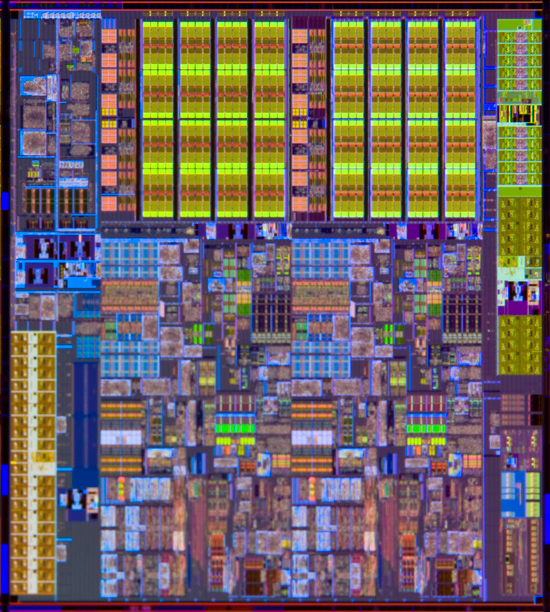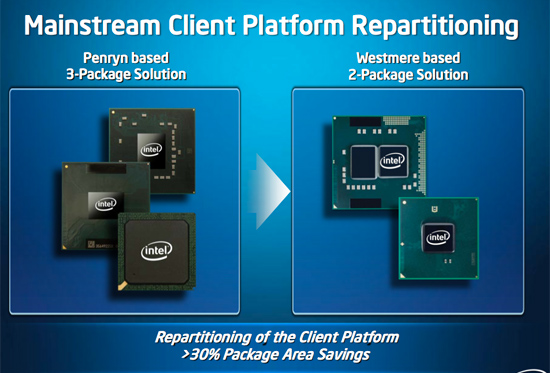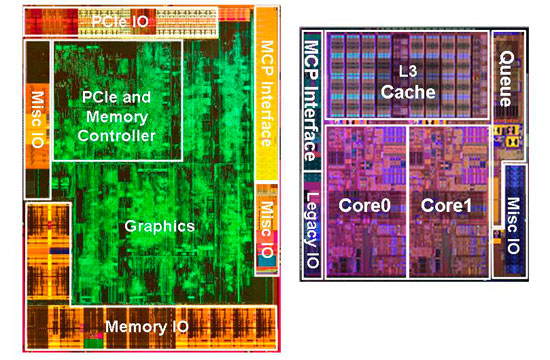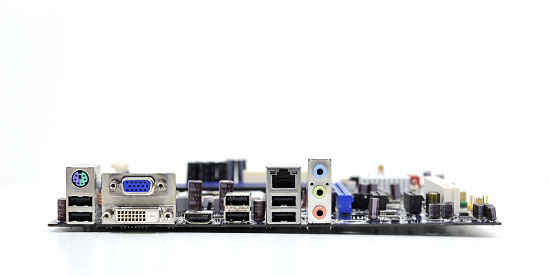The Clarkdale Review: Intel's Core i5 661, i3 540 & i3 530
by Anand Lal Shimpi on January 4, 2010 12:00 AM EST- Posted in
- CPUs
I swear this is the longest it’s taken for an Intel architecture to penetrate the market. We first met Nehalem on November 3rd, 2008. It came to us as a high end quad-core processor and took a full year to make it to more affordable motherboards in the form of Lynnfield. Even with P55 motherboard prices down at the magical $99 marker, Intel relinquished control of the $100 - $200 CPU market without a Nehalem to compete down there. Instead we were left with a choice between Penryn, the update to Intel’s 2006 Conroe architecture, or Phenom II, AMD’s low-cost Nehalem competitor. The choice was simple.
From $100 to $200, your best bet has been AMD. Either through aggressive pricing on quad-core CPUs or the L3-cache-less Athlon II line, AMD controls the $100 - $200 market. Today we meet Intel's first 32nm CPUs, codename Clarkdale, designed to specifically target that $100 - $200 market.

Two cores, Nehale..err Westmere-style
Technically Clarkdale isn’t Nehalem, it’s Westmere. Take Nehalem, use 32nm transistors, add in some new instructions for accelerating encryption/decryption, and you’ve got the makings of Westmere.
Clarkdale uses a dual-core Westmere and sticks it next to a 45nm Intel GMA die. That’s right, meet the first (er, second) Intel CPU with on-chip graphics. Next year we’ll see Sandy Bridge bring the graphics on-die, but until then we have Intel’s tried and true multi-chip-package to tide us over.

We don’t get on-die graphics yet because Intel still hasn’t switched over to its make-everything-at-the-best-process-ever strategy. The 32nm fabs are ramping up with CPU production and the 45nm fabs need something to do. Nearly every desktop and laptop sold in 2010 will need one of these 45nm GMA die, so the fabs indeed have something to do.
It’s not all rosy with Clarkdale unfortunately. Remember the memory controller that Nehalem so graciously integrated? Clarkdale kicks it off die again. The IMC is housed in the 45nm GMA die. It’s still on-package, but not on-die. The benefit is super fast memory access for the graphics core, but slower memory access for the CPU core. In fact, this is a derivative of the memory controller used in older Intel chipsets (e.g. P45/X48).

The CPU connects to the GMA die using QPI, so bandwidth shouldn’t be as big of a problem. Latency is unfortunately hurt as a result. Access times can be longer than older LGA-775 processors thanks to this memory controller design being optimized for FSB architectures. Again, the problem goes away with Sandy Bridge, but today we’re faced with it.
Like Lynnfield, Clarkdale uses Intel’s LGA-1156 socket. Clarkdale should work in all P55 motherboards, but you’ll need a BIOS update. No existing P55 motherboards route video from the socket to a VGA/DVI/HDMI connector, so you’ll need a new motherboard if you want to take advantage of the on-package graphics. Enter the H55, H57 and Q57 chipsets.

A typical H57 I/O layout
The H and Q-series of chipsets feature what Intel calls its Flexible Display Interface (FDI). This is basically a link between the CPU and the chipset that passes along video output. H5x/Q57 motherboards will have a video out on board so you can use Clarkdale’s integrated graphics.
The chipsets differ in price and features. The table below sums it up:
Support for Intel’s Rapid Storage Technology is probably the main reason you’ll want H57 over H55. The difference between H57 and Q57 boils down to security and management features. The H-series is for consumers, the Q-series is for corporate customers. Make sense?
The chips themselves are pretty straightforward. Intel is launching seven desktop Clarkdale processors (and a whole lot more notebook Arrandale chips):
| Processor | Core Clock | Cores / Threads | L3 Cache | Max Turbo | TDP | Price |
| Intel Core i5-670 | 3.46GHz | 2 / 4 | 4MB | 3.76GHz | 73W | $284 |
| Intel Core i5-661 | 3.33GHz | 2 / 4 | 4MB | 3.60GHz | 87W | $196 |
| Intel Core i5-660 | 3.33GHz | 2 / 4 | 4MB | 3.60GHz | 73W | $196 |
| Intel Core i5-650 | 3.20GHz | 2 / 4 | 4MB | 3.46GHz | 73W | $176 |
| Intel Core i3-540 | 3.06GHz | 2 / 4 | 4MB | N/A | 73W | $133 |
| Intel Core i3-530 | 2.93GHz | 2 / 4 | 4MB | N/A | 73W | $113 |
| Intel Pentium G9650 | 2.80GHz | 2 / 2 | 3MB | N/A | 73W | $87 |
The six processors labeled Core i5s and Core i3s all have the same basic architecture. You get per-core 256KB private L2s and you get a 4MB L3 cache shared among both cores (down from 8MB from the quad-core Lynnfield/Bloomfield chips). The i5s get turbo mode while the i3s do not. The i5-661 uses a higher graphics clock and has a higher TDP than the 660. Remember that these are CPU+GPU combos on a single package, so GPU clocks do vary based on model.

The Clarkdale lineup is honestly made up of CPUs that are too expensive. The Core i5 670, 661/660 and 650 are all priced above $170 and aren’t worth the money. The problem is Lynnfield’s turbo mode gives you high enough clock speeds with two threads that there’s no need to consider a dual-core processor. You can buy a Core i5 750, have more cores than any of these Clarkdales and run at close enough to the same frequencies for $196. Or you can buy a Phenom II X4 965 for about the same price and have much better multi-threaded performance. The chips that are most interesting are the Core i3s.
| Processor | Clock Speed | Max Turbo | |
| 2 Cores Active | 1 Core Active | ||
| Intel Core i5-670 | 3.46GHz | 3.60GHz +3.9% | 3.73GHz +7.7% |
| Intel Core i5-661 | 3.33GHz | 3.46GHz +4.0% | 3.60GHz +8.0% |
| Intel Core i5-660 | 3.33GHz | 3.46GHz +4.0% | 3.60GHz +8.0% |
| Intel Core i5-650 | 3.20GHz | 3.33GHz +4.2% | 3.46GHz +8.3% |
| Intel Core i3-540 | 3.06GHz | N/A | |
| Intel Core i3-530 | 2.93GHz | N/A | |
Turbo just isn't as interesting with only two cores. With four cores you used to have to make a tradeoff between good 4 and 2 threaded performance, but Lynnfield fixed that. No one really debates single vs. dual core anymore. The single core turbo modes are great, but aren't worth the money. Pay attention to the i3s.











93 Comments
View All Comments
Anand Lal Shimpi - Monday, January 4, 2010 - link
You're very right, it appears to be a side effect of the ASUS H57 board looking at everyone else's results. I'm out in Vegas at CES now but I'll run some numbers on Intel's H55 when I return this weekend.Take care,
Anand
plonk420 - Monday, January 4, 2010 - link
this power consumption is a bit weird... i've actually done the same testpc power & cooling 750 watt
i7-920, ex58-ud3r, 3x1 DDR3, hd5870, 2 hdds, 3 fans, HT on
default voltage: 215 watts in p95 (122 watts idle, no powersave mode)
undervolted 1.125v: 187 watts in p95 (121 watts idle, no powersave mode)
default, 8600GT: 211 watts in p95 (116 watts idle, no powersave mode), 184 watts on "sane load" (distributed computing)
1.125v, 8600GT: 183 watts in p95 (115 watts idle, no powersave mode), 164 watts on "sane load" (distributed computing)
i7-860, ex-p55m-ud2, 4x1 DDR3, 5870, 2 hdds, 2 fans, HT on
default voltage: (either i lost results, or i never tested them)
undervolted 1.025v: 167 watts p95 (107 watts idle, 101 watts in power saver), 149 watts on enigma@home (8 instances)
Spoelie - Monday, January 4, 2010 - link
The Load Power Consumption on page 4 also raises questions.The Phenom system rises 90w to decode a x264 movie, while the clarkdale system only rises 20w. It seems to me that the clarkdale system had DXVA support on while the Phenom system had it off..
Can someone check/confirm this?
Anand Lal Shimpi - Monday, January 4, 2010 - link
I was caught off guard by it too but DXVA was enabled. I'm currently out in Vegas for CES but when I return I'll give it another look in our Core i3 review. I've had issues with power consumption being stuck at unusually high levels on AMD boards in the past, but I couldn't get this one to shake in time.Take care,
Anand
MrAwax - Monday, January 4, 2010 - link
HD Codec bitstreaming has been added in HDMI 1.3 specs at the receiver manufacturer request for no reason except that they did want to lose their market.Since HD codecs are LOSSLESS, decoding them in the player or in the receiver makes NO difference. And HDMI supports streaming of 8 uncompressed channels in LPCM @192kHz/24b since 1.0. So digitally, there is ZERO POINT ZERO difference. This is the reason it is useless. And this is the reason HDMI added 8 channels of high resolution audio so you won't need to upgrade your receiver !
And this is stupid because bitstreaming is a LIMITATION of feature, not an added feature. BluRay norm supports in player audio mixing. A lot of discs are already supporting it. The player can mix sounds live on the main soundtrack. This is useful for adding dynamic menu sounds or director/actor commentary. In theory, the disc could even have a single music/fx soundtrack and dynamically mix voice to support multiple langage and save space on disc (voice is generally stereo, is not always present and reencoding every time the music/fx is a waste of storage). With HDMI bitstreaming, you can stream the main track only. Gone is the menu fx sound, gone is the bonus commentary and gone is the voice.
Welcome to receiver manufacturer lobbying for USELESS and STUPID feature.
PS: on the contrary, 8 channels hires LPCM is a great feature.
salacious - Monday, January 4, 2010 - link
Bitstreaming does have the disadvantages of loosing audio track mixing but it does offer something.If the decoding is done in the PC were are relying it to not to downsample to 48kHz/16bit which happens unless you have the correct combination of player and audio card. If the decoding is done in the PC you are relying that it decodes to the correct speaker and I have found that with a 7.1 speaker setups this is a complete mess.
Also if you want to apply any receiver effects to the audio then over HDMI you tend to be limited. If the movie is 5.1 and it is EX encoded and you have a 6.1/7.1 speaker setup, then the usual solution is to apply this processing in the receiver but if you set your PC to 7.1 then it sends 2 blank audio channels and you can't apply EX processing. You have the same problem is you play back a surround encoded stereo track on a 5.1 speaker system, all that happens is that the audio is output from the left/right speakers and you are unable to apply pro-logic decoding to it.
A solution would be for the PC to offer Pro-logic IIx and other types of decoding but as they don't then you need the receivers to do it which means bitsreaming.
FlyTexas - Monday, January 4, 2010 - link
...Is this really needed?Ok, so more speed is good, I wouldn't turn it down... ...however anyone who uses computers in the office environment knows that CPUs have been "fast enough" for awhile now.
We currently have a dozen Dell Vostro 200's with Pentium Dual Core 1.6ghz CPUs, and a dozen Dell Vostro 220's with Pentium Dual Core 2.4ghz CPUs in the office (among a few other oddball machines and the server).
These computers run Office 2007, Adobe Acrobat 9, IE 8, etc. Some of them also run Quickbooks and a few other programs. None are used for video encoding, games, or anything that fancy.
You know what? The difference between the 1.6ghz machines and the 2.4ghz machines isn't all that noticeable, once everything is up and running (they all have 2GB of RAM, running Windows XP Pro SP3). They all have the Intel GMA graphics, and for the office, they are all plenty fast.
Why would our company upgrade to these new CPUs?
The Pentium Dual Core CPUs were a nice jump over the Pentium 4 line. (we used to have all Pentium 4 machines back in 2006) This new line of CPUs doesn't seem like the same kind of improvement.
tomaccogoats - Monday, January 4, 2010 - link
I only look at new cpu's for gaming :plowlight - Monday, January 4, 2010 - link
You might notice a difference if they were running Windows 7 with 4GB of ram. Right now they are all a bit bottlenecked by the OS (poor multitasking performance) and low amount of RAM.But in general I agree with what you're saying.
FlyTexas - Monday, January 4, 2010 - link
I have Windows 7 installed on my computers at home, I haven't moved the office machines due to a lack of any good reason to do so.We have Windows 2003 R2 Small Business Server at work. Everyone is on user accounts on a domain. We have a hardware firewall running as well as the usual antivirus/spam/etc. stuff running.
It all just works, I have no desire to rip it all apart, spend a lot of the company's money, to gain... well I'm not sure what we'd gain. If I can't think of a good reason to do it, I sure can't sell it to the boss.
This isn't a knock against Microsoft, I personally love Windows 7, it is great for my home computer, but it doesn't do anything for the work computers. In a larger company, I can see the benefits of moving to it (and Server 2008), but we just don't have that large of a network (or budget).
As a side note: You wouldn't have wanted to see the mess that was here when I got here, it was all running on a wireless linksys router on an unencrypted network. I managed to get the office wired with gigabit ethernet and turn off the wireless. Got a good server in place, setup a Dell account, and moved out most of the oddball machines (we did two lease purchases of machines, one for each dozen of the Vostros, got a heck of a deal on them too). Of course I sold this to the boss by saying that it would all last at least 5 years, and we're about 2 years into that 5 year plan. :)
Maybe we'll just skip Windows 7 and move to 8 when it comes out.